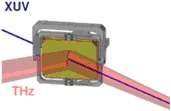Scientists study processes using high-intensity ultrashort X-ray pulses

Many physical and chemical processes occur on extremely short time and length scales – as a rule within quadrillionths of a second on lengths of billionths of a metre. Researchers study such processes using intense ultrashort X-ray flashes. As is well known from photography: the faster a process occurs, the shorter the exposure must be which makes it visible. Such intense, ultrashort X-ray flashes are generated in large research facilities, so-called free-electron lasers. A new method developed in Hamburg and Berlin now enables researchers to make use of the full time resolution of these large-scale facilities for the first time. The group from DESY, HZB, the European XFEL GmbH and the Helmholtz Institute Jena presents its results in the current online issue of Nature Photonics.
The generation of X-ray flashes that are only a few femtoseconds (quadrillionths of a second) long has been possible for some years. Such flashes can be produced by free-electron lasers (FEL), such as FLASH at the DESY research centre in Hamburg, LCLS in Stanford (USA) and the X-ray laser European XFEL currently under construction. So far, however, experiments only reached time resolutions of typically around one hundred femtoseconds – i.e., two orders of magnitude worse than the actual pulse durations. The problem was to determine precisely when the X-ray pulse arrived at the experiment.
A research group from the Helmholtz-Zentrum Berlin für Materialien und Energie (HZB), DESY, the European XFEL GmbH and the Helmholtz Institute Jena has now found a way to measure the arrival time of the X-ray pulses with a precision of less than ten femtoseconds. The method is based on a so-called cross-correlation.
The new method was developed at the free-electron laser FLASH for so-called pump-probe processes. As an example: a first ultrashort pump pulse triggers a photochemical reaction. A second X-ray radiation pulse takes a “photograph” of how the reaction proceeds. For the first time, researchers are now able to determine exactly at what time the picture produced by the second pulse is created. For this new method, they make use of a side effect of the X-ray pulse generation. Indeed, the electron bunch accelerated in FLASH emits both an X-ray flash and an intense terahertz flash at the same time. The researchers separate the two flashes using a perforated, gold-coated mirror. As both pulses are created at the same time and from the same electron bunch, the terahertz flash can be used as a temporal “marker” of the X-ray flash. Using this method, the researchers were able to determine the time at which the X-ray pulse arrived at the sample with a precision of seven femtoseconds.
The new method can be used at all existing and planned new FEL sources given only very slight modifications. In combination with appropriate experiments, it opens up the possibility to fully exploit the potential of these large-scale facilities. For the first time, phenomena can now be studied with X-rays on the relevant femtosecond time scale – something scientists have long been waiting for.
More information: Nature Photonics publication: DOI: 10.1038/NPHOTON.2010.311
Provided by DESY




















